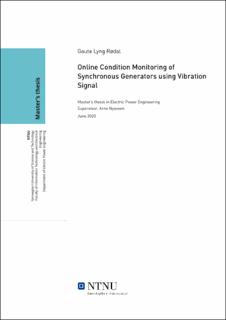| dc.description.abstract | Vannkraft er blant de reneste energikildene og stod for 95% og 16% av den totale energiproduksjonen i henholdsvis Norge og verden i 2018. Synkrongeneratoren med utpregende poler er den enerådende maskinen brukt for elektromekanisk konvertering av energi i vannkraftanlegg og dens plikt er således uvurderlig. Til tross for at denne typen generator er robust og sørger for pålitelig kraftproduksjon, kan den bli utsatt for feil som hindrer produksjonen. En alvorlig feil kan medføre kostbare reparasjoner, skape farlige situasjoner og føre til produksjonsstopp med tilhørende store økonomiske tap. Deteksjon av feil i tidlig stadium før deres alvorlighetsgrad øker er derfor viktig for lønnsom og stabil produksjon, og kontinuerlig overvåking via vibrasjonsmålinger er en effektiv måle å diagnostisere en generator. Overvåking av vibrasjoner i synkrongeneratorer med utpregede poler har likevel ikke blitt tilstrekkelig utforsket, noe som gjør forskning på dette området nødvendig.
Denne masteroppgaven undersøker om og hvordan vibrasjonssignaler kan bli brukt til feildeteksjon av kortslutningsfeil i rotor og statisk eksentrisitet i synkrongeneratorer med utpregede poler. En ny analytisk modell som inkluderer geometrien til polene, sporene i stator, metning av jernet og konsekvensene av de to nevnte feilene har blitt utledet og brukt til å predikere kreftene i luftgapet til en maskin med liknende konstruksjon som en vannkraftgenerator. I tillegg har den samme generatoren blitt modellert og simulert med elementmetoden og detaljerte analyser av flukstettheten, krafttettheten og den totale kraften i luftgapet er presentert i tids- og romdomenet. Den resulterende statorvibrasjonen er også studert og evaluert ut ifra masteroppgavens mål.
Resultatene viser at vibrasjoner med én til seks ganger rotasjonsfrekvensen til rotoren og med to til fire ganger den synkrone, elektriske frekvensen kan bli brukt til deteksjon av kortslutningsfeil i rotor og statisk eksentrisitet. Kjennetegn på hvordan de to feilene kan skilles fra hverandre er formulert og lineære likninger som anslår feilens alvorlighetsgrad som en funksjon av deformasjon er utledet. Kortslutningsfeil er funnet til å være farligere for en generator enn statisk eksentrisitet ut ifra vibrasjonene de forårsaker, på grunn av eksitasjon av unaturlige harmoniske komponenter i både tids- og romdomenet. Statisk eksentrisitet påvirker også kreftene i rommet, men skaper svakere vibrasjoner på grunn av sin statiske oppførsel. I tillegg, tids- og romharmoniske komponenter av den radielle kraften formulert av den nye analytiske modellen samsvarer godt med analysene fra elementmetoden og skaper et pålitelig grunnlag for prediksjon av vibrasjon.
Masteroppgaven innfrir sitt mål og viser at vibrasjonssignaler kan bli brukt til deteksjon av kortslutningsfeil i rotor og statisk eksentrisitet i synkrongeneratorer med utpregede poler ved å studere vibrasjonsnivået ved spesifikke frekvenser. Funnene kan ses på som verdifulle for feildeteksjon og overvåkning av vannkraftgenertorer, selv om eksperimentelle målinger på den simulerte generatoren bør bli gjennomført i fremtiden for å undersøke gyldigheten til resultatene i praksis. | |
| dc.description.abstract | Hydropower is among the cleanest sources of energy and accounted for 95% and 16% of the total energy production in Norway and worldwide in 2018, respectively. The salient-pole synchronous generator is the supreme machine used for electromechanical energy conversion in hydropower plants and its duty is in this way indispensable. This type of generator is robust and provides reliable power production, however, it may be exposed to faults that impede the operation. A serious fault can require an expensive overhaul, lead to dangerous incidents, and cause generation stoppage with huge economical losses as a consequence. Thus, detection of faults at an incipient stage before their severity intensifies is essential for profitable and stable operation, and on-line condition monitoring by measuring vibration is an effective way to diagnose a generator. However, vibration monitoring of salient-pole synchronous generators has not been explored to the extent it deserves, despite the important responsibility of these machines, which causes an urgent need for more research.
This master's thesis investigates whether and how vibration signals can be used for detection of inter-turn short circuit (ITSC) in the rotor winding and static eccentricity (SE) in salient-pole synchronous generators. A novel analytical model that considers the salient-pole geometry, stator slots, iron saturation, and the effects of the two faults is formulated and used to predict the air-gap forces in a machine with topology of a typical hydropower generator. Moreover, the same generator is modeled and simulated with the finite element method and detailed analyses of the air-gap flux density, force density, and total force during healthy and faulty condition in the time domain and the spatial domain are conducted. The resulting stator vibration is also examined and evaluated with respect to the thesis objective.
It is found that vibration at one to six times the rotor rotational frequency and at two to four times the synchronous electrical frequency can be used to detect ITSC in the rotor and SE. Classifiers to distinguish the two faults from each other are obtained and linear equations to determine the fault severity as a function of deformation are deduced. ITSC fault is found to be more dangerous for the generator than SE based on the vibration they produce due to excitation of unnatural harmonics in the time domain and the spatial domain. SE affects the spatial force distribution as well, however, causes milder vibration due to its static nature. Moreover, time harmonics and spatial harmonics of the radial force density formulated by the novel analytical model are in good agreement with the finite element analysis and form a reliable basis for prediction of vibration.
The thesis fulfills its objective and shows that vibration signals can be used for detection of ITSC in the rotor winding and SE in salient-pole synchronous generators by evaluating the vibration level at certain frequencies. Its findings can be regarded as valuable for fault detection and on-line condition monitoring of hydropower generators, however, experimental measurements on the investigated generator should be conducted as further work to examine the validity of the results in practical applications. | |
